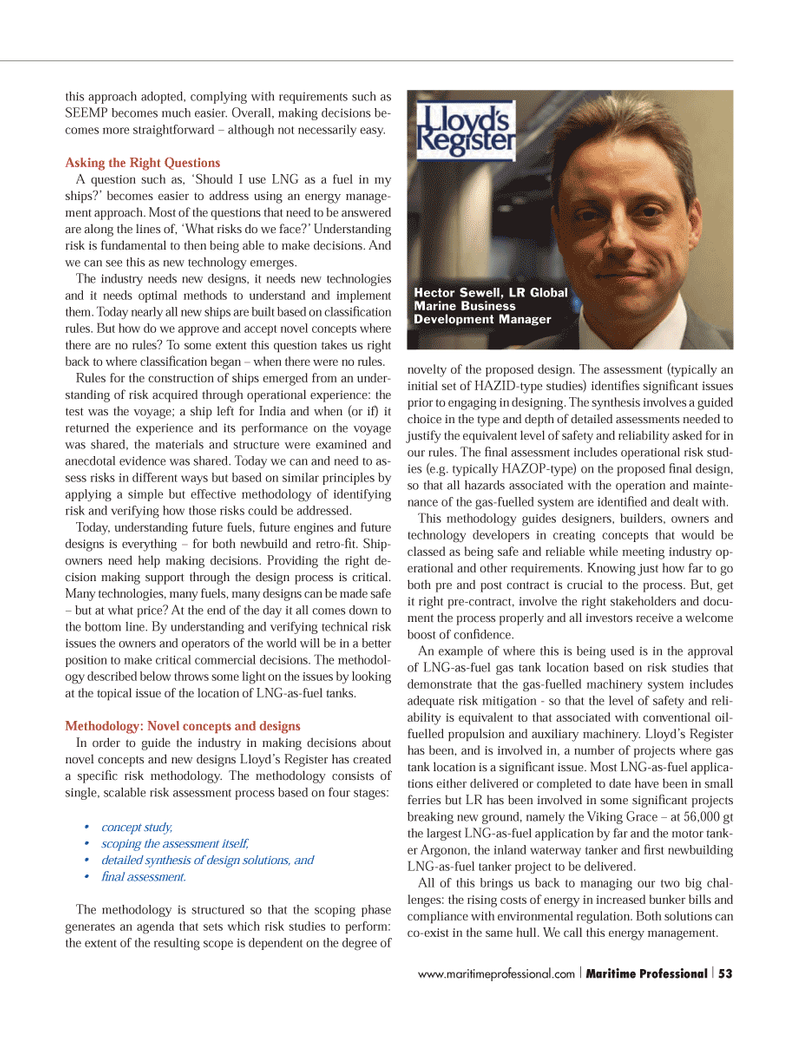
Page 53: of Maritime Logistics Professional Magazine (Q3 2012)
Classification Societies, Quality & Design
Read this page in Pdf, Flash or Html5 edition of Q3 2012 Maritime Logistics Professional Magazine
this approach adopted, complying with requirements such as SEEMP becomes much easier. Overall, making decisions be- comes more straightforward ? although not necessarily easy. Asking the Right QuestionsA question such as, ?Should I use LNG as a fuel in my ships?? becomes easier to address using an energy manage- ment approach. Most of the questions that need to be answered are along the lines of, ?What risks do we face?? Understanding risk is fundamental to then being able to make decisions. And we can see this as new technology emerges. The industry needs new designs, it needs new technologies and it needs optimal methods to understand and implement them. Today nearly all new ships are built based on classi cation rules. But how do we approve and accept novel concepts where there are no rules? To some extent this question takes us right back to where classi cation began ? when there were no rules. Rules for the construction of ships emerged from an under- standing of risk acquired through operational experience: the test was the voyage; a ship left for India and when (or if) it returned the experience and its performance on the voyage was shared, the materials and structure were examined and anecdotal evidence was shared. Today we can and need to as- sess risks in different ways but based on similar principles by applying a simple but effective methodology of identifying risk and verifying how those risks could be addressed. Today, understanding future fuels, future engines and future designs is everything ? for both newbuild and retro- t. Ship- owners need help making decisions. Providing the right de- cision making support through the design process is critical. Many technologies, many fuels, many designs can be made safe ? but at what price? At the end of the day it all comes down to the bottom line. By understanding and verifying technical risk issues the owners and operators of the world will be in a better position to make critical commercial decisions. The methodol- ogy described below throws some light on the issues by looking at the topical issue of the location of LNG-as-fuel tanks. Methodology: Novel concepts and designs In order to guide the industry in making decisions about novel concepts and new designs Lloyd?s Register has created a speci c risk methodology. The methodology consists of single, scalable risk assessment process based on four stages: concept study, scoping the assessment itself, detailed synthesis of design solutions, and nal assessment. The methodology is structured so that the scoping phase generates an agenda that sets which risk studies to perform: the extent of the resulting scope is dependent on the degree of novelty of the proposed design. The assessment (typically an initial set of HAZID-type studies) identi es signi cant issues prior to engaging in designing. The synthesis involves a guided choice in the type and depth of detailed assessments needed to justify the equivalent level of safety and reliability asked for in our rules. The nal assessment includes operational risk stud- ies (e.g. typically HAZOP-type) on the proposed nal design, so that all hazards associated with the operation and mainte-nance of the gas-fuelled system are identi ed and dealt with. This methodology guides designers, builders, owners and technology developers in creating concepts that would be classed as being safe and reliable while meeting industry op-erational and other requirements. Knowing just how far to go both pre and post contract is crucial to the process. But, get it right pre-contract, involve the right stakeholders and docu- ment the process properly and all investors receive a welcome boost of con dence.An example of where this is being used is in the approval of LNG-as-fuel gas tank location based on risk studies that demonstrate that the gas-fuelled machinery system includes adequate risk mitigation - so that the level of safety and reli- ability is equivalent to that associated with conventional oil- fuelled propulsion and auxiliary machinery. Lloyd?s Register has been, and is involved in, a number of projects where gas tank location is a signi cant issue. Most LNG-as-fuel applica- tions either delivered or completed to date have been in small ferries but LR has been involved in some signi cant projects breaking new ground, namely the Viking Grace ? at 56,000 gt the largest LNG-as-fuel application by far and the motor tank- er Argonon, the inland waterway tanker and rst newbuilding LNG-as-fuel tanker project to be delivered. All of this brings us back to managing our two big chal- lenges: the rising costs of energy in increased bunker bills and compliance with environmental regulation. Both solutions can co-exist in the same hull. We call this energy management. Hector Sewell, LR Global Marine Business Development Managerwww.maritimeprofessional.com | Maritime Professional | 53

 52
52

 54
54
